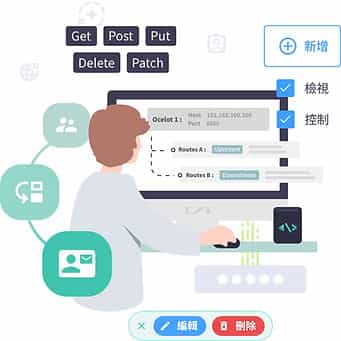What is API Gateway
API Gateway is a gateway management and control system for Web API. It receives the first entry (gateway) of all APIs and a key role that assists the processing of microservices distribution to the backend. API is the primary solution for the interfacing between systems. When customers start to build API services, they need API Gateway to centrally control authentication and authorization mechanisms.

Why you need API Gateway
In response to the maturity of 5G systems and the development trend of AIoT, the application of microservice architecture is becoming more and more popular, and all microservices rely on API to communicate with the external devices and services. Therefore, API Gateway can communicate in series more securely, effectively, and easily, which reduces enterprise R&D investment, focuses on the core business of the enterprise, and improves operational efficiency.
Product Advantages: Microservice Architecture / Comply with the Open API Specification / API Management System
Microservice Architecture
The microservice architecture makes the application more flexible and establishes the application program based on independent deployment. Each service has an independent life cycle, improving the management ability of the system. Microservices can be expanded independently, only need to adjust the functional areas that require more processing power or network bandwidth to support the demand, using less hardware, thereby saving enterprise costs.

Comply with the Open API Specification
The service complies with the Open API Spec. of open modules, has the characteristics of high flexibility and easy customization, allows customers to develop related applications by themselves.

API Management System
CSI API Gateway provides a complete API management system, allowing developers to easily complete API routing settings, with complete authentication and authorization modules to improve system security protection. It manages API traffic to maintain system stability; combines with comprehensive log records, which detailed API data can be obtained. It reduces enterprise R&D investment, allowing enterprises to focus on core business and improve operational efficiency.

Product Features
Request Routing
Routing is the foundation of API Gateway and the most central module function. The main function of this feature is to forward a request to the target microservice based on the incoming request from the client, and then return the result of the request to the client. It also supports receiving all styles of routes, allowing users to specify all requests they want to match.

WebSocket
WebSocket can establish bidirectional real-time data transmission and provides an API Gateway continuous connection mechanism to process the message transmission between the backend service and the client to keep the connection uninterrupted.

Authentication
In any situation, when requesting access to any protected microservice, the authentication module of API Gateway will be accessed first, which will direct the request to the identification or verification microservice to obtain access token, allowing users access under protected microservices. And even if you need to access multiple microservices, you only need to authenticate once, reducing latency and ensuring that the authentication process is consistent.

Authorization
API Gateway supports claims-based access authorization, which checks whether the user has the statement permission, and whether the value of the statement has been registered. Executes the authorization after authentication, so that the user can successfully access the microservice.

Rate Limiting
API Gateway supports flow control for client (Upstream) requests, so that microservices (Downstream) will not crash due to overload. A variety of control rules (whitelist, cycle, etc.) can be defined to provide high-quality services for most users.

Request Logging
API Gateway provides error management program overall to capture and record any abnormal messages. Also record the API request logging from the beginning to the end, and any abnormal messages caused by middleware, so that the development team can find problems easily.

Configuration REST API
By configuring REST API routing rules, it can support the conversion of HTTP request methods, so that the client can send requests to microservices normally.
